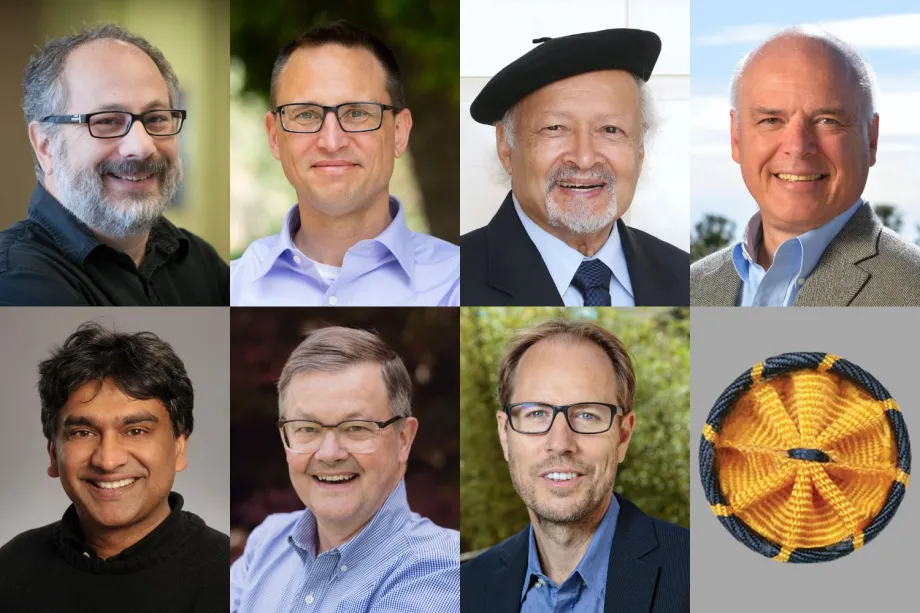
(Top, from left) Thomas Devereaux, Ian Fisher, Thomas Kailath, and David Miller. (Bottom, from left) Bali Pulendran, Robert Waymouth, and Tony Wyss-Coray. (Image credit: Courtesy Thomas Devereaux/Alex Johnson Photography/Courtesy Thomas Kailath/Rod Searcey/Jack Kearse, Emory/Jia Zhang/Gary Wagner)
Stanford Report News - April 18th, 2024
Seven researchers from Stanford University have been named fellows of the American Association for the Advancement of Science (AAAS). AAAS describes its Fellows as a “distinguished cadre of scientists, engineers, and innovators who have been recognized for their achievements across disciplines, from research, teaching, and technology, to administration in academia, industry, and government, to excellence in communicating and interpreting science to the public.”
This year, AAAS named 502 new fellows. The seven fellows from Stanford are:
Thomas Devereaux – For distinguished contributions to the field of computational materials science, particularly using light and X-ray techniques to study the ultrafast properties of complex and important materials.
Devereaux is a professor of photon science at SLAC National Accelerator Laboratory and of materials science and engineering at in the School of Engineering. He is a senior fellow at the Precourt Institute for Energy and a principal investigator with the Stanford Institute for Materials and Energy Sciences (SIMES), a joint institute of SLAC and Stanford.
Ian Fisher – For distinguished contributions to the field of synthesis of novel materials through crystal growth and developing new experimental techniques, including elastoresistance and elastocaloric, impacting studies of electronic nematicity.
Fisher is a professor of applied physics in the School of Humanities and Sciences (H&S) and a principal investigator with SIMES.
Thomas Kailath – For contributions to information and system sciences, sustained mentoring of young scholars, and translating theoretical breakthroughs to practical products through startup ventures.
Kailath is the Hitachi America Professor in the School of Engineering, Emeritus, and professor emeritus of electrical engineering.
David Miller – For fundamental contributions to optoelectronics and nanophotonics with broad applications to communications and information processing.
Miller is the W. M. Keck Professor of Electrical Engineering in the School of Engineering.
Bali Pulendran – For his transformative impact on human immunology and vaccinology by pioneering the use of systems approaches to understand immunity to vaccination and infection in humans.
Pulendran is the Violetta L. Horton Professor and professor of microbiology and immunology in the School of Medicine. He is also a member of Stanford Bio-X and a faculty fellow of Sarafan ChEM-H.
Robert Waymouth – For contributions to advancing the discipline of chemistry by developing new organometallic and organic catalysts, especially for the synthesis of macromolecules.
Waymouth is the Robert Eckles Swain Professor of Chemistry in H&S. He is also a member of Bio-X and the Stanford Cancer Institute, a faculty fellow of Sarafan ChEM-H, and an affiliate of the Stanford Woods Institute for the Environment.
Tony Wyss-Coray – For distinguished research on mechanisms of brain aging and neurodegeneration with potential to lead to new biomarkers and treatments for a range of neurodegenerative diseases, including Alzheimer’s and Parkinson’s disease.
Wyss-Coray is the D.H. Chen Distinguished Professor of Neurology and Neurological Sciences in the School of Medicine and director of the Phil and Penny Knight Initiative for Brain Resilience at Stanford University. He is also a member of Bio-X, the Wu Tsai Human Performance Alliance, the Maternal & Child Health Research Institute , and the Wu Tsai Neurosciences Institute.



